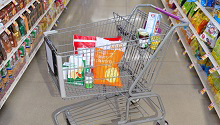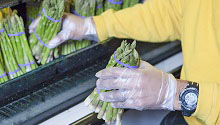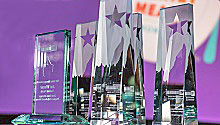CHICAGO, IL — May 7, 2007 — Supermarket industry sales increased 5.3 percent in 2006, and same-store sales rose 4.0 percent, the highest mark for this performance measure in more than a decade, according to the Food Retailing Industry Speaks: Annual State of the Industry Review 2007 released here today by the Food Marketing Institute (FMI). These figures were up from 4.6 percent and 2.4 percent, respectively, in 2005.
The national chains reported a banner year in sales and profit growth, but the picture was far less rosy for many other retailers. In fact, same-store sales decreased for nearly one-quarter (23.5 percent) of food retailers. All together, nearly half (47.1 percent) lost ground in same-store sales when factoring in inflation.
Net income before taxes and extraordinary items decreased to 1.8 percent, from 2.1 percent. Retailers with more than 100 stores reported the highest income numbers at a median of 3.2 percent.
"These results are impressive in view of all the rising costs the industry must bear, including energy, healthcare, credit card interchange fees and the imperative to keep improving products and services in today’s extraordinarily competitive marketplace," said FMI Senior Vice President Michael Sansolo. "However, it is also clear that many retailers are struggling to solve the puzzle of cutting costs as much as possible while continually improving customer service."
Meal Solutions Proliferate and Niche-Marketing Remains Strong
Retailers are responding aggressively to diverse and changing customer demands, delivering fresh, healthful and convenient products storewide.
They are offering meal solutions in multiple forms, including:
• Hot-service counters, 89.2 percent.
• Self-service refrigerated cases, 83.8 percent.
• Made-to-order sandwiches, 71.6 percent
• Soup bars, 67.6 percent.
• Catering, 62.2 percent.
• Separate checkouts for prepared foods, 58.1 percent.
• Salad bars, 56.8 percent.
• Sushi stations, 52.9 percent.
• Snack/juice/coffee bars, 50.0 percent.
Prepared foods departments have grown large with the median number of items offered at 62. The menu items range from traditional chicken to made-to-order pasta dishes, paninis and burritos. Chicken remains the most popular item, prepared in a wide variety of forms including barbequed, broasted, fried, rotisserie and tenders.
The industry continues to reach out to fast-growing market niches. As many as 83.9 retailers offer ethnic foods and 72.4 percent feature a natural/organic food aisle or section. Nearly half of the retailers surveyed (46.0 percent) are branding their own organic foods, selling private label versions of these products.
Anxiety High Over a Record Host of Strategic Issues
Looking at the future, the report found increased concern over a growing host of strategic issues. In fact, the level of concern, measured on a scale on 1 to 10 with 10 being the highest, increased for nearly every issue, comparing the expected impact in 2006 with that in 2007-2008. Further, more issues had an anxiety rating of 6 or higher than ever before in this report:
• Healthcare costs, 7.9 in 2007-2008, up from 7.6 in 2006.
• Competition from other retailers, 7.7, up from 7.5.
• Credit/debit card interchange costs, 7.5, up from 7.2.
• Energy costs, 7.4, down slightly from 7.5.
• Staffing, hiring, retention, 6.9, up from 6.5.
• Technology investments, 6.5, up from 6.0.
• Food safety scares, 6.0, up from 5.7.
The frustration over some of the issues stems from the industry’s inability to control them. The most significant example is interchange fees, averaging nearly 2 percent, which credit card companies and banks extract from every plastic transaction.
Interchange fees are fixed by Visa, MasterCard and the banks that issue their cards. The cost is rising fast for three reasons: the fees themselves keep increasing, more consumers are using rewards cards with higher interchange rates and plastic is becoming the predominant way that consumers pay for goods and services.
Interchange costs for all retailers totaled $30.7 billion in 2005 and $36.3 billion in 2006 — an 18 percent increase in just one year. The cost of interchange has more than doubled since 2001. In the long run, consumers pay these costs as retailers are forced to build them into the price of all goods and services.
How Retailers Are Rising to Meet Competitive Challenges
Nearly all retailers (98.8 percent) are addressing competition issues by emphasizing perishable products such as meat, produce, prepared foods and deli and bakery items. This strategy is yielding success with an effectiveness rating of 8.6 with 10 being the highest.
Companies are also competing by developing store brands (87.8 percent); focusing on natural and organic products (84.1 percent); providing a unique shopping experience, store design and product selection (74.4 percent); emphasizing consumer wellness and family health (73.2 percent); and featuring low prices (72.0 percent).
Methodology and Purchasing Information
The data for this report are based on surveys of 92 companies operating 14,769 stores, filings with the Securities and Exchange Commission and information from the U.S. Bureau of Labor Statistics and Census Bureau. The analysis is also based on other FMI research, including U.S. Grocery Shopper Trends 2007, Facts About Store Development 2006 and the 2005-2006 Annual Financial Review.
This report was made possible by the generous support of American Express. To purchase Food Retailing Speaks: The Annual State of the Industry Review 2007 ($95 for FMI retailer/wholesaler members, $145 for FMI associate members and $195 for nonmembers), contact the FMI Store by calling 202-220-0723 or visiting www.fmi.org/store/.
Contact:
Bill Greer
202-220-0667
wgreer@fmi.org
 Industry Topics address your specific area of expertise with resources, reports, events and more.
Industry Topics address your specific area of expertise with resources, reports, events and more.
 Our Research covers consumer behavior and retail operation benchmarks so you can make informed business decisions.
Our Research covers consumer behavior and retail operation benchmarks so you can make informed business decisions.
 Events and Education including online and in-person help you advance your food retail career.
Events and Education including online and in-person help you advance your food retail career.
 Food Safety training, resources and guidance that help you create a company food safety culture.
Food Safety training, resources and guidance that help you create a company food safety culture.
 Government Affairs work — federal and state — on the latest food industry policy, regulatory and legislative issues.
Government Affairs work — federal and state — on the latest food industry policy, regulatory and legislative issues.
 Get Involved. From industry awards to newsletters and committees, these resources help you take advantage of your membership.
Get Involved. From industry awards to newsletters and committees, these resources help you take advantage of your membership.
 Best practices, guidance documents, infographics, signage and more for the food industry on the COVID-19 pandemic.
Best practices, guidance documents, infographics, signage and more for the food industry on the COVID-19 pandemic.
